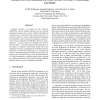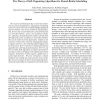329 search results - page 26 / 66 » Self: The Power of Simplicity |
CSIE
2009
IEEE
14 years 2 months ago
2009
IEEE
Topographic maps are an appealing exploratory instrument for discovering new knowledge from databases. During the past years, new types of Self Organizing Maps (SOM) were introduc...
ICDCS
2008
IEEE
14 years 1 months ago
2008
IEEE
Self-stabilization is a strong property which guarantees that a network always resume a correct behavior starting from an arbitrary initial state. Weaker guarantees have later bee...
IPPS
2007
IEEE
14 years 1 months ago
2007
IEEE
Dynamic networks, e.g. Mobile Ad Hoc Networks (MANETs), call for adaptive protocols that can tolerate topological changes due to nodes’ mobility and depletion of battery power. ...
SASO
2007
IEEE
14 years 1 months ago
2007
IEEE
The study of synchronization has received much attention in a variety of applications, ranging from coordinating sensors in wireless networks to models of fireflies flashing in...
FMCAD
2007
Springer
14 years 1 months ago
2007
Springer
— The concept of applying partial fencing to logic built-in self test (LBIST) hardware structures for the purpose of using partially good chips is well known in the chip design i...


